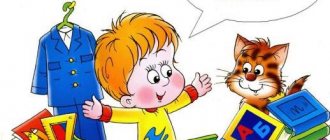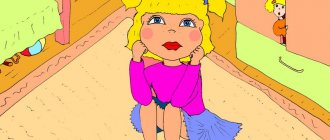Distinguish between "left" and "right"
For studying in general and so as not to confuse the concepts of “clockwise” and “counterclockwise” as well.
Have a general understanding of time
We explain to the child the concepts of “yesterday”, “today”, “tomorrow”; "past present Future"; “morning”, “day”, “evening”, “night”, “day”. Often children themselves associate time with a specific event: “in the morning I did exercises”, “at lunch I ate soup”, “before going to bed I brushed my teeth”, etc. Therefore, when explaining the above concepts, it is best for a parent to tie specific events to them.
Correct your child carefully if he makes mistakes somewhere. It is important that he does not develop a false understanding of time.
Have you successfully completed the preparatory stage? Now we can teach the child to understand time using a clock with arrows.
We teach a child to understand time using a clock with arrows
Oh, these adults! And why do they only allow you to watch cartoons for about 15 or 20 minutes? For children, time is an incomprehensible number. To figure out where it comes from, you will need a watch with hands. If there are no such things at home, but only electronic ones, it will be completely difficult for the child to understand what time is. Therefore, the first step for a parent is to acquire a wall clock or a special children's clock, on which the numbers and arrows will be clearly visible.
Introducing the child to the structure of the clock
First, explain to your child the concepts of “dial”, “day”, “hours”, “minutes”, “seconds”; “exactly one hour”, “half an hour”, “quarter of an hour”, tell us about the hour, minute, second hands. Please note that all arrows have different lengths. Let the child observe which of the arrows is the fastest and which one practically stands still. And how long does it take for each to complete the whole circle?
Be sure to connect all the basic concepts into one logical chain: there are 24 hours in a day, 1 hour is 60 minutes, and 1 minute is 60 seconds. Do not ignore the concepts of “clockwise” and “counterclockwise”. Let your child understand that time always moves forward.
We teach a child to “read” the hour and minute hands at the same time
First of all, teach your child to count minutes in intervals divisible by 5. Minutes are not indicated on a regular clock, so this skill needs to be practiced. You can come up with a legend that each number on the dial has its own “shadow”. 1 is 5 minutes, 2 is 10 minutes, 3 is 15 minutes, etc. The “shadow” can only be seen when the minute hand is pointing to the number. When your child can easily navigate five-minute intervals, tell him about smaller intervals.
The hour hand also has two meanings. In the first half of the day we see the numbers as they appear on the dial, but after a hearty afternoon snack at 12:00 they begin to “get fat”: 1 turns into 12, 2 into 14, etc. A funny analogy will help your child grasp the meaning faster.
The ability to determine time using a clock with hands must be reinforced with specific examples. Draw your child's attention to the clock more often. Correct him if he says the time incorrectly.
The best gift for a child who is learning to tell time by clock is a wristwatch. With them, he will become more willing to answer the question “What time is it?” and will definitely ask you about this in order to check with his “walkers”.
Ideally, a child should have a “draft” watch that he can “exploit” as he pleases: set the time on it, add “shadows” to each of the numbers, sign the names of the hands. For training, you can use an old non-working clock (wall or table clock). You need to remove the glass in them so that the hands can be rotated. If you haven't found one like this at home, we suggest you make your own.
Explaining the essence of time
By the age of three, children, as a rule, know what morning, afternoon, evening are, and how they differ. To teach this, you can use visual aids: cards, pictures, cubes, books. Tell your child when the sun rises, when it sets, and what we do at certain times of the day. For example, in the morning we wake up, wash our face, brush our teeth, and have breakfast. At lunch we eat soup and go to bed for the day.
In the evening it gets dark, the whole family has dinner, then the baby bathes, listens to a fairy tale, and goes to bed. As you know, children perceive new information better during play. Let your favorite toys (dolls, bears, bunnies) wake up, have breakfast, go for a walk, and go to bed. At the same time, talk about what time of day it is for the toys, explain why right now they should go to bed or wake up.
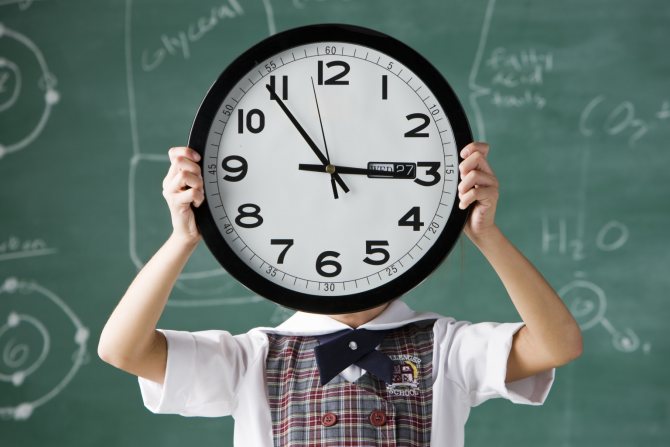
Interesting : We warn correctly about the punishment. Useful methods and advice from psychologists
Making homemade watches
A homemade clock will help make time more tangible. If you have the necessary materials, their creation will take no more than 15 minutes.
How to make a watch yourself
The basis for the dial can be a disposable plate or a circle made of cardboard. We draw the circle in half, then in half again and apply the first numbers. Next, carefully divide each quarter into three parts and add the remaining numbers. The dial is ready, which means it's time to attach the hands. We cut them out of cardboard of different colors and attach them to the circle using a button. We place the resulting model of the clock next to the real clock.
When creating your own watch, it will be useful to go over the concepts you have already learned. We drew the circle into four parts - we remembered about the “quarter hour”, attached an hour hand - we remembered its function, etc.
Homemade watches may look unusual. For example, like this:
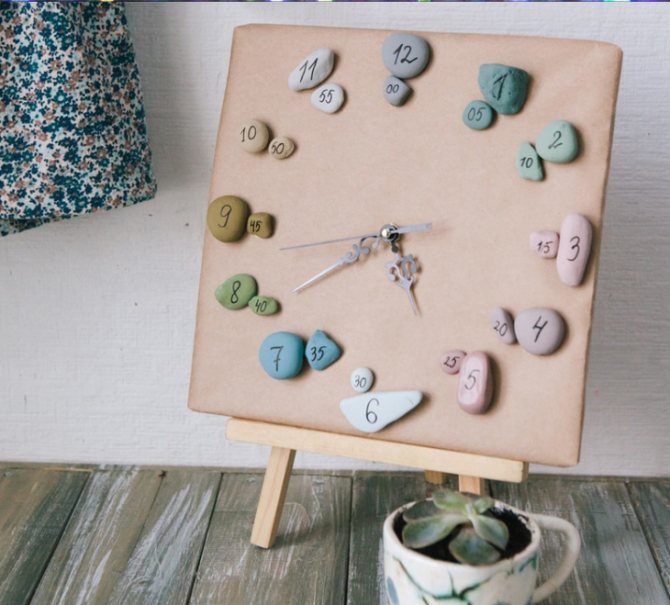
At what age is a child ready to understand time?
Obviously, it is best for a child to understand how to tell time by a clock before he goes to school. It’s good if the baby himself shows interest in this topic, asking his mother questions: “Is 10 minutes a very long time?”, “How soon will we go for a walk,” etc.

It’s great if the child himself shows interest in the topic of time, the structure of clocks, and asks his parents relevant questions
Before starting training, parents should give the child a general understanding of time (how it moves, what the past, present and future are, the time of day).
This is usually explained to preschoolers in kindergarten. However, not all children attend preschool or do so irregularly.
In addition, in order to understand how the clock works, the child must be able to count to 60 and know how the indicated numbers are written. It will also be great to understand counting with fives and tens (this is not necessary, but will be just perfect).
Therefore, the specific age at which you need to start learning to tell time using a clock cannot be stated unambiguously (each child is individual, as well as the pace of his development). Some people are ready for this as early as 5 years old, others only at 7 years old.
Games and tasks with a clock
Games and tasks will help you strengthen your ability to tell time using a clock.
"What time is it now"
Show your child how the arrows move. Change their position and call the time. Then have the child do the same exercise. Change the time clockwise and counterclockwise.
Let's complicate the game. We show the time on the clock and associate it with events (“it’s 7:00”, at this time we wake up”, “it’s 18:00”, at this time we have dinner”, etc.). Now we invite the child to pretend to live the whole day.
“Drawing pizza”
The good thing about a homemade dial is that you can make your own notes on it. Ask your child to draw lines from the center of the dial to the numbers and shade each sector with a different color. You will get a “colored pie” or “colored pizza” (this will make it easier to understand 5-minute intervals). Label the second values of each number (2 - 10, 3 - 15) and minutes (from 1 to 60).
"Daily regime"
Take a piece of paper, write down the daily routine, and together with your child, illustrate it with images of a clock that indicates a period of time (8:00 - time for school, 15:00 - time to do homework, etc.). Hang it above your child's bed or desk. This way the child will learn not only to do everything on time, but also to navigate in time.
Pay your child's attention to how much time he spends on this or that action. This way you can teach him to be punctual from an early age.
“Two options for telling the time”
Tell your child that time can be called in different ways (for example, 1 hour 18 minutes is eighteen minutes past two, etc.). Write down the second, more complex option on a piece of paper, and indicate the hint numbers to make it easier for the child to cope (example: “five minutes to eight”, the hint numbers are 9, 5, 5, 1). Gradually remove the prompts.
Games for learning time concepts
To quickly teach a child about a clock, you need to use various didactic games. At the stage of getting to know the parts of the day, for example, you can play the game “Say the Word.”

The adult says a phrase that the child must complete: “We have breakfast in the morning, and have lunch...” or “We go to kindergarten in the morning, and come back...”

- You can also play on the playground by uniting preschoolers in a circle. An adult with a ball in the center of the circle. He throws the ball to any of the children and calls the time of day, day of the week or month, depending on the level of readiness of the children, and the child calls what follows: “Day - evening, May - June, Monday - Tuesday.”
- With a group of children you can play the game: “Week, line up!” Each is assigned a day of the week. At the command “Scatter!” everyone scatters within the playground, and at the command: “Week, line up!” arranged in a row according to the order of the days of the week.
Summarize. If parents set out to teach their child to tell the clock, they must be patient and act consistently.
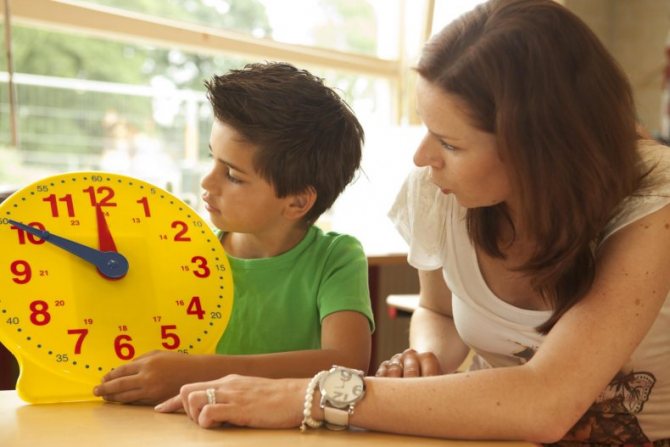
The main principle is from simple to complex and regularity. Well, no pressure on the child. If he finds it difficult to master the hours, it is worth postponing classes to a later period.
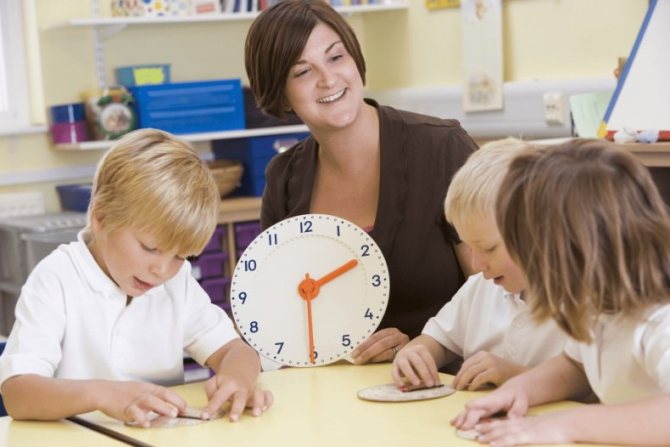
How to explain to a child what time is
If you ask an adult: “What is time?”, he may answer that it is a certain parameter, or a certain interval between events, or he will express some other philosophical reflection.
Have you ever wondered how a child will answer this question? What is the concept of “time” for him? Do a simple experiment and ask your children. The answers may be very interesting.
To gradually give your child an idea of time, it is necessary to form the following concepts:
- Times of Day;
- season;
- units of time;
- passage of time (fast, long, often, rarely, yesterday, today, tomorrow).
These concepts are given to preschoolers by parents and kindergarten teachers. To do this, they can use the following techniques: conversations, stories, games, poems, riddles. Before explaining clock time to a child, it is important to prepare him for the perception of time in a broader sense.
Seasons
At 3 years old, a preschooler begins to associate weather with seasons. At first, these are primary and pronounced signs: in summer it’s hot, in winter it’s cold.
With growing up, the amount of information gradually increases, and by the age of 7, the child knows the number and order of seasons, the number of months in a year, the order of months, and the classification of months by season.
Children receive all this information by watching the weather, looking at illustrations, memorizing poems, and listening to riddles. For better memory fixation, each month is associated with a natural phenomenon, human activity, or some holiday.
For example: Mom explains to the baby: “Winter has come. Look, it's snowing outside. Let's put on a fur coat, hat and boots. Cold. Children are making a snowman. New Year is coming, we will decorate the Christmas tree, and Santa Claus will bring gifts.”
Particular attention is paid to the calendar. With its help, the child will be able to clearly understand long periods of time: day, week, month, year.
Four times of day
Children begin to learn simple concepts of “day and night” before the age of 3 years. Later they begin to understand the meaning of “morning - evening”. To formulate these concepts, it is recommended to use pictures with the actions of animals or people at different times of the day, didactic games (“When does this happen?”), riddles, and nursery rhymes.
For example, guess the riddle: “The children went for a walk, they are observing. The sun is shining brightly in the sky, the birds are singing happily. (Day)
Note: In order for the child to correctly form concepts about the time of day, before napping you should not automatically say “Good night”, you should wish “Good sleep”.
Hourly intervals
At the age of 5 - 7 years, you can teach children to understand time by clock. How to determine the exact age point?
If a preschooler himself begins to show interest in watches, asks to explain what the watch shows, where the hands are, when his favorite cartoon starts, what time dad will return from work, then your child is ready to learn complex information about hour intervals.
And in order for this information to contribute to the perception of time, and not a superficial understanding of the “numbers” on the clock, the preliminary preparation described above is precisely important.




